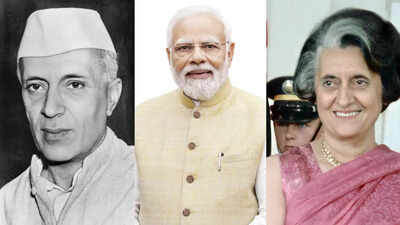India’s 10 longest-serving Prime Ministers: Narendra Modi surpasses Indira Gandhi’s legacy to become second longest in history | India News

Since India’s Independence in 1947, the role of Prime Minister has been central to shaping the country’s political, social, and economic trajectory. Leading the world’s largest democracy demands not just administrative skill but visionary leadership capable of managing diverse populations, geopolitical challenges, and rapid development. Over the decades, India has seen 14 Prime Ministers whose tenures range from a few days to over sixteen years. In a historic political milestone, Prime Minister Narendra Modi has officially surpassed Indira Gandhi to become India’s longest-serving Prime Minister. This achievement marks not just the longevity of his leadership but also a shift in India’s political narrative from the Congress era’s dominance under Gandhi to the BJP-led transformative governance model under Modi. His tenure, spanning economic reforms, digital innovation, foreign policy assertiveness, and ambitious social welfare schemes, has redefined India’s global positioning. The tenures of these Prime Ministers highlight the evolving nature of Indian democracy from Nehru’s foundational vision, through Indira Gandhi’s transformative yet controversial years, to Modi’s contemporary leadership reshaping India’s global position. Their diverse leadership styles and legacies continue to influence India’s political and socio-economic fabric.
List of longest serving Prime Ministers of India
Prime Ministers who served the longest in India
Jawaharlal Nehru
As India’s first Prime Minister, Nehru served nearly 17 years, establishing foundational democratic institutions, secularism, and non-alignment in foreign affairs. His vision fostered a mixed economy, initiating industrialisation and social reforms. Nehru’s leadership during the formative years was instrumental in uniting a diverse nation post-independence.
Narendra Modi
Assuming office in 2014, Modi has transformed India’s political landscape with initiatives like Digital India, Make in India, and Swachh Bharat Mission. His foreign policy has focused on global partnerships, while domestically he has pursued economic reforms and infrastructure growth. Surpassing Indira Gandhi’s continuous tenure, Modi represents a new era of leadership marked by decisive governance and political longevity.
Indira Gandhi
Indira Gandhi, India’s first and only woman Prime Minister, steered the country through turbulent times including the Green Revolution, the Emergency period (1975–77), and the 1971 war leading to Bangladesh’s creation. Her tenure was marked by centralisation of power and efforts to consolidate national unity.
Manmohan Singh
An economist by training, Singh is credited with spearheading India’s 1991 economic liberalisation as Finance Minister before becoming Prime Minister. His decade in office was characterised by steady economic growth, expanding India’s global economic ties, and efforts to improve social welfare.
Atal Bihari Vajpayee
Vajpayee’s leadership blended pragmatic governance with nationalism. He led India through nuclear tests in 1998, promoted infrastructure development via the Golden Quadrilateral highway project, and sought peace with Pakistan through diplomacy. His oratory skills and coalition-building helped stabilize a politically fragmented era.
Rajiv Gandhi
Taking office after Indira Gandhi’s assassination, Rajiv Gandhi was India’s youngest Prime Minister. He pushed for technological advancement, modernised telecom infrastructure, and attempted economic reforms. His tenure was abruptly ended by electoral defeat and his assassination in 1991.
P. V. Narasimha Rao
Often called the ‘Father of Indian Economic Reforms,’ Rao’s government liberalised the economy, reducing licence controls and opening India to foreign investment. He faced political challenges but is widely credited with transforming India’s economic trajectory in the 1990s.
Morarji Desai
As the first non-Congress Prime Minister, Desai’s government focused on reducing corruption, decentralising power, and restoring democratic norms post-Emergency. His tenure was marked by political instability but set a precedent for coalition governments in India.
Lal Bahadur Shastri
Shastri’s short but impactful tenure included promoting agricultural self-sufficiency and leading India during the 1965 Indo-Pak war. His slogan “Jai Jawan Jai Kisan” remains a symbol of patriotism and agrarian pride.
Vishwanath Pratap Singh
Singh is best known for implementing the Mandal Commission recommendations, introducing reservation for Other Backward Classes (OBC) in government jobs and education. His policies triggered widespread social and political debates, fundamentally reshaping India’s caste dynamics.




